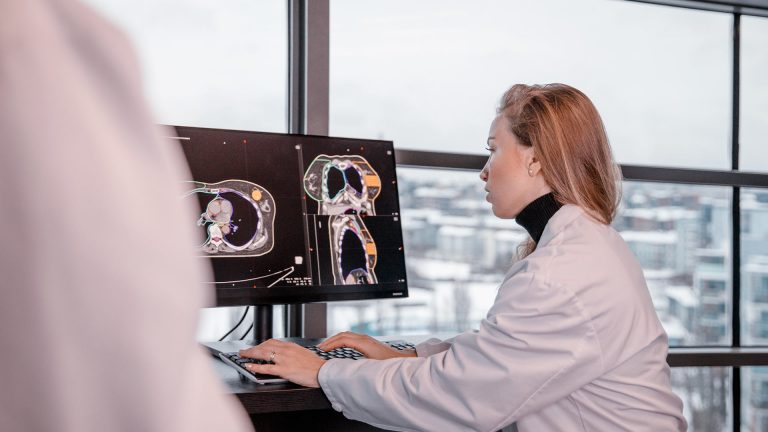Breast and ovarian cancer are both diseases that have adversely impacted the lives of so many women and their families. 2020 was the most prevalent year for breast cancer so far. There were 2.3 million women diagnosed with breast cancer, Ovarian cancer accounts for 2.5% of cancers in women. According to the World Ovarian Cancer Coalition, a recent study predicted that by 2035, there will be a worldwide increase in ovarian cancer by 55%, and a 67% increase in deaths caused by ovarian cancer. A contributing factor to overall deaths and diagnosis of breast and ovarian cancer are the BRCA genes.
What is BRCA?
BRCA is an abbreviation for Breast Cancer gene. There are two different types of genes that impact an individual’s chance of developing breast cancer: BRCA1 and BRCA2. According to the National Breast Cancer Foundation, every human has both BRCA1 and BRCA2 genes, and they normally play a big role in preventing breast cancer by repairing DNA breaks that lead to cancer and uncontrolled tumor growth. Although this is the case, some people’s BRCA1 and BRCA2 genes do not function properly.
Who is affected by BRCA gene mutations?
According to the National Cancer Institute, people who inherit harmful variants in BRCA 1 or BRA2 have increased risks of several types of cancers and are particularly at risk for breast and ovarian cancer. People who have inherited a harmful mutation in BRCA1 and BRCA2 are also more likely to develop cancer at younger ages. These harmful variants can be inherited from either parent. Any child who carries a mutation has a 50% chance of inheriting the mutation, and it is present from birth in all of the cells in their body.

What happens when people inherit BRCA gene mutations?
Women who inherit a harmful mutation of the BRCA1 gene have a 55%-72% chance of developing breast cancer and a 39-44% chance of developing ovarian cancer. Women who inherit a harmful mutation of the BRCA2 gene have a 45%-69% chance of developing breast cancer and a 11%-17% chance of developing ovarian cancer. Women with either BRCA gene mutation are also at an increased risk to develop fallopian tube cancer, primary peritoneal cancer, and pancreatic cancer. Men with BRCA2 and BRCA1 mutations are also at increased risk of both breast cancer and pancreatic, as well as prostate cancer.
What is the difference between BRCA 1 and BRCA2 mutations?
Although they are similar BRCA1 and BRCA2 are found on different chromosomes. BRCA1 is located on chromosome 17 and BRCA2 is found on chromosome 13. As previously mentioned, each mutation affects an individual’s risk of developing specific types of cancer differently.
How can you find out if you carry a BRCA gene mutation?
According to Mayo Clinic, testing for BRCA gene mutations is typically done with a blood test. In more rare cases, other samples may be collected for DNA analysis, including saliva.

If your relatives carry the BRCA gene mutations, it is recommended that you get tested for the BRCA1 and BRC2 mutations. If you are unsure if any family members carry either BRCA gene mutations, you may be a candidate for BRCA genetic testing. Here are some of the many factors stated by Mayo Clinic, that can increase your candidacy for BRCA genetic testing:
- A personal history of breast cancer diagnosed before age 45
- A personal history of breast cancer diagnosed before age 50 and a second primary breast cancer
-
A personal history of two or more types of cancer
-
A personal history of ovarian cancer
-
A personal history of male or breast cancer, or multiple relatives with breast cancer before the age of 50
MVision AI assists oncology departments and cancer patients with their radiotherapy needs.
MVision AI is experienced in standardizing organ-at-risk contouring, and automating segmentation in radiotherapy to streamline breast cancer treatment planning, along with many other cancer types. MVision is guideline-based, following many consensus guidelines to guarantee the highest quality and most accurate services possible. MVision’s GDPR-compliant services help medical professionals in their radiotherapy workflow. This in turn helps cancer patients carrying BRCA gene mutations, as well as many other cancer types, to receive timely and consistent radiotherapy treatment.

If you are interested in learning more about MVision’s consistent, timesaving, services, visit our website and follow us on LinkedIn.
For further questions and concerns, contact us: :
c/o Terkko Health Hub, Haartmaninkatu 4, 00290 Helsinki, Finland.
Tel: +358 (0) 40 5489 229
Email: info@mvision.ai
For media inquiries:
Tel: +358 40 500 7915
Email: pr@mvision.ai
Sources


